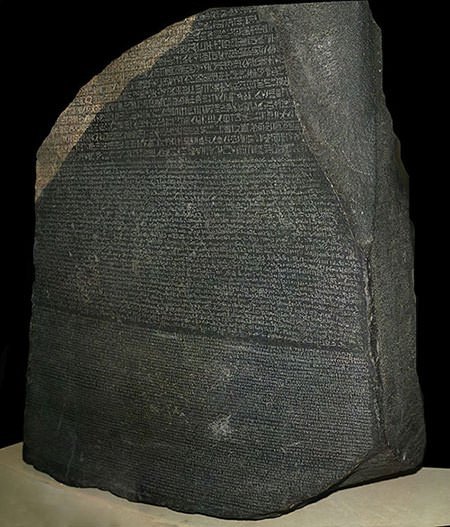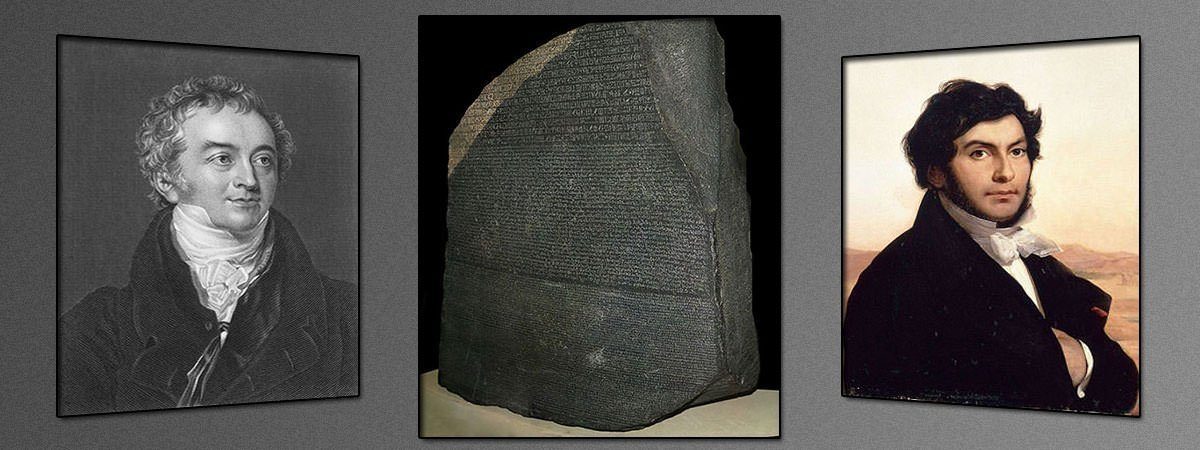The Rosetta Stone is a 112.3 cm high, 75.7 cm wide and 28.4 cm thick fragment of a larger stele of granodiorite igneous rock. It created a sensation when it was rediscovered in 1799 as it was the first Ancient Egyptian bilingual text recovered in modern times and held the key to decipher the mysteries of ancient Egypt. Rosetta Stone is so famous because its discovery led to decipherment of hieroglyphs, understanding of ancient Egyptian history and birth of the entire field of modern Egyptology. Here are 10 interesting facts about this remarkable stone.
#1 ROSETTA STONE WAS CARVED ABOUT 2220 YEARS AGO
The Rosetta Stone was carved in 196 BC. It was produced during the reign of ancient Egyptian pharaoh Ptolemy V Epiphanes, the fifth ruler of the Ptolemaic dynasty. Epiphanes became ruler at the age of five in 204 BC and he reigned till 181 BC. Rosetta Stone was erected in the ninth year of his reign after his coronation. It was inscribed with the third decree of Memphis which established the rule of Ptolemy V. The decree for most part lists the good deeds done by Ptolemy V for the priests and people of Egypt, describes the repeal of various taxes by the Pharaoh and contains instructions of erecting statues in temples.

#2 THREE SCRIPTS WERE USED On It
The same decree was displayed in three different scripts on the stone. The upper text was Ancient Egyptian hieroglyphs, the script used for important or religious documents which was understood by only about 1% of ancient Egyptians. The middle portion was demotic, the common script of Egypt at the time used for writing records, letters etc. The lowest portion was ancient Greek, script of the Egyptian rulers of the time. Hence by using three scripts it was ensured that priests, government officials and rulers could all read the decree.

#3 IT GOT ITS NAME FROM A CITY IN EGYPT
It is widely believed that the Rosetta Stone was originally displayed in a temple. It was probably moved in the middle ages and then surprisingly it was used as building material for the construction of Fort Julien, built by the Ottoman Empire. When Napoleon Bonaparte invaded Egypt in 1798, French troops under Lieutenant Pierre-Francois Bouchard rediscovered the stele on July 15, 1799 while reconstructing the fort. As the fort was a couple of miles from the Egyptian port city of Rosetta (modern day Rashid), it was called the Rosetta Stone.

#4 IT IS THE MOST VISITED OBJECT IN THE BRITISH MUSEUM
In 1801, French troops in Egypt were defeated by British and Ottoman forces. They retreated to Alexandria where they were besieged. In August 1801 under the Capitulation of Alexandria, the Rosetta Stone was transferred to British possession. In 1802, it was moved to the British Museum in London where it remains to this day. It is on public display and is the most popular object in the museum.
#5 IT Helped Decipher ANCIENT EGYPTian Script
When the stele was discovered the first two texts were unreadable by the scholars but Greek was known to them. Since the same decree was written in three scripts, Rosetta Stone provided an opportunity to uncover the mysterious Egyptian culture by deciphering hieroglyphic inscriptions found on the walls of tombs, obelisks, pyramids and other ancient Egyptian artifacts.

#6 LAST KNOWN USE OF HIEROGLYPHS WAS IN 396 AD
The use of hieroglyphs rapidly declined after Roman Emperor Theodosius I closed all non-Christian temples in 391 AD. The last known inscription is dated to 24 August 396 AD. The ability to decipher Hieroglyphic writing had been lost for more than a thousand years. The challenge to unravel Rosetta Stone was that no one knew much about the hieroglyphs, like whether they were simply symbols or letters of a spoken language; or whether they were written from right to left or left to right. Add to this that the three texts didn’t match word for word and owing to the damaged state of the stele, none of the three texts were absolutely complete.

#7 THOMAS YOUNG CONTRIBUTED IN DECIPHERing The HIEROGLYPHS
Before it was taken by Britain, the French made copies of inscriptions on the stone. This started a competition between scholars of the two nations to be the first to decipher it. English polymath Thomas Young was the first to make significant advances. He noted as many as 80 similarities between the hieroglyphic and demotic texts on the stone thus establishing in 1814 that the two scripts, previously thought to be entirely different, were pervasive. He also discovered the phonetic characters “p t o l m e s” in the hieroglyphic text on the stone that were used to write the Greek name “Ptolemaios” thus becoming the first to translate any hieroglyphic text on the stone.

#8 JEAN-FRANCOIS CHAMPOLLION Was Its FIRST TRANSLATOR
French scholar and linguist Jean-Francois Champollion believed he could crack hieroglyphs through the ancient languages of Egypt. He studied the last known language spoken during the time of the hieroglyphs, Coptic. He worked out a hypothetical hieroglyphs alphabet. His alphabet was proved and it was conformed that by using it he could read words written 3000 years ago. In 1822, 24 years after the discovery of the stele, Champollion published the first translation of the Rosetta Stone hieroglyphs. He went on to develop a first Ancient Egyptian grammar and a hieroglyphic dictionary.

#9 EGYPT WANTS IT BACK
In July 2003 Zahi Hawass, the chief of Egypt’s Supreme Council of Antiquities, asked for the return of Rosetta Stone to Egypt as it is an ‘ icon of Egyptian identity.’ In 2005, the British Museum presented Egypt with a full-size replica of the stele but there are still demands for permanent return of the original.

#10 THE TERM ROSETTA STONE HAS BECOME POPULAR IN OTHER CONTEXTS TOO
Rosetta Stone is so famous that the term is used idiomatically to describe “something which provides the key to previously unattainable understanding”. The term has been used multiple times in other fields like fully understanding the key set of genes to the human leucocyte antigen has been described as being “the Rosetta Stone of immunology”. The Rosetta spacecraft launched by the European Space Agency to perform a detailed study of comet 67P/Churyumov–Gerasimenko has been named after the stele hoping it will lead to understanding the origins of the Solar System.


100%!
Omg, Thanks heaps! This gave me and A+ in my history assessment! This helped a lot!
Happy to help.